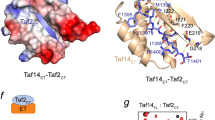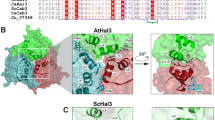Abstract
Dimerization is proposed to be a regulatory mechanism for TATA-binding protein (TBP) activity bothin vitro andin vivo. The reversible dimer-monomer transition of TBP is influenced by the buffer conditionsin vitro. Usingin vitro chemical cross-linking, we found yeast TBP (yTBP) to be largely monomeric in the presence of the divalent cation Mg2+, even at high salt concentrations. Apparent molecular mass of yTBP at high salt with Mg2+, run through a gel filtration column, was close to that of monomeric yTBP. Lowering the monovalent ionic concentration in the absence of Mg2+, resulted in dimerization of TBP. Effect of Mg2+ was seen at two different levels: at higher TBP concentrations, it suppressed the TBP dimerization and at lower TBP levels, it helped keep TBP monomers in active conformation (competent for binding TATA box), resulting in enhanced TBP-TATA complex formation in the presence of increasing Mg2+. At both the levels, activity of the full-length TBP in the presence of Mg2+ was like that reported for the truncated C-terminal domain of TBP from which the N-terminus is removed. Therefore for full-length TBP, intra-molecular interactions can regulate its activity via a similar mechanism.
Similar content being viewed by others
Abbreviations
- BMH:
-
Bismaleimidohexane
- TBP:
-
TATA-binding protein
- yTBP:
-
yeast TBP
References
Bell B and Tora L 1999 Regulation of gene expression by multiple forms of TFIID and other novel TFIID complexes;Exp. Cell. Res. 246 11–19
Buratowski S, Hahn S, Sharp P A and Guarente L 1988 Function of a yeast TATA element binding protein in a mammalian transcription system;Nature (London) 334 37–42
Burley S K and Roeder R G 1996 Biochemistry and structural biology of transcription factor IID (TFIID);Annu. Rev. Biochem. 65 769–799
Campbell K M, Ranallo R T, Stargell L A and Lumb K J 2000 Reevaluation of transcriptional regulation by TATA-Binding protein oligomerization: Predominance of monomers; Biochemistry 39 2633–2638
Chasman D I, Flaherty K M, Sharp P A and Kornberg R D 1993 Crystal structure of yeast TATA-binding protein and model for interaction with DNA;Proc. Natl. Acad. Sci. USA 90 8174–8178
Coleman R A, Taggart A K P, Benjamin L Rand Pugh B F 1995 Dimerization of the TATA Binding Protein;J. Biol. Chem. 270 13842–13849
Coleman R A and Pugh B F 1997 Slow dimer dissociation of TATA binding protein dictates the kinetics of DNA binding;Proc. Natl. Acad. Sci. USA 94 7221–7226
Coleman R A, Taggart A K P, Burma S, Chicca II J J and Pugh B F 1999 TFIIA regulates TBP and TFIID dimers;Mol. Cell 4 451–457
Daugherty M A, Brenowitz M and Fried G 1999 The TATA binding protein fromSaccharomyces cerevisiae oligomerizes in solution at micromolar concentrations to form tetramers and octamers;J. Mol. Biol. 285 1389–1399
Daugherty M A, Brenowitz M and Fried G 2000 Participation of the amino-terminal domain in the self-association of the full-length yeast TATA binding protein;Biochemistry 39 4869–4880
Goffeau A, Barrell B G, Bussey H, Davis R W, Dujon B, Feldmann H, Galibert F, Hoheisel J D, Jacq C, Johnston M, Louis E J, Mewes H W, Murakami Y, Philippsen P, Tettelin H and Oliver G G 1996 Life with 6000 genes;Science 274 546, 563–567
Hernandez N 1993 TBP, a universal transcription factor?;Genes Dev.7 1291–1308
Horikoshi M, Yamamoto T, Ohkuma Y, Weil P A and Roeder R G 1990 Analysis of structure-function relationship of yeast TATA box binding factor TFIID;Cell 61 1171–1178
Icard-Liepkalns C 1993 Binding activity of the human transcription factor TFIID;Biochem. Biophys. Res. Commun. 193 453–459
Imbalzano A N, Zaret K S and Kingston R E 1994 Transcription factor (TF) IIB and TFIIA can independently increase the affinity of the TATA-binding protein for DNA;J. Biol. Chem. 269 8280–8286
Jackson-Fisher A J, Burma S, Portnoy M, Schneeweis L A, Coleman R A, Mitra M, Chitikila C and Pugh B F 1999a Dimer dissociation and thermosensitivity kinetics of theSaccharomyces cerevisiae and human TATA Binding Proteins;Biochemistry 38 11340–11348
Jackson-Fisher A J, Chitikila C, Mitra M and Pugh B F 1999b A role for TBP dimerization in preventing unregulated gene expression;Mol. Cell 3 717–727
Jupp R, Flores O, Nelson J A and Ghazel P 1993 The DNA binding subunit of human transcription factor IID can interact with the TATA box as a multimer;J. Biol. Chem. 268 16105–16108
Kato K, Makino Y, Kishimoto T, Yamauchi J, Kato S, Muramatsu M and Tamura T 1994 Multimerization of the mouse TATA-binding protein (TBP) driven by its C-terminal conserved domain;Nucleic Acids Res. 22 1179–1185
Kuddus R and Schmitz M C 1993 Effect of the non-conserved N-terminus on the DNA binding activity of the yeast TATA binding protein;Nucleic Acids Res. 21 1789–1796
Lee T I and Young R A 1998 Regulation of gene expression by TBP-associated proteins;Genes Dev. 12 1398–1408
Lescure A, Lutz Y, Eberhard D, Jacq X, Krol A, Grummt I, Davidson I, Chambon P and Tora L 1994 The N-terminal domain of the human TATA-binding protein plays a role in transcription from TATA-containing RNA polymerase II and III promoters;EMBO J. 13 1166–1175
Lieberman P M, Schmidt M C, Kao C C and Berk A J 1991 Two distinct domains in the yeast transcription factor IID and evidence for a TATA Box induced conformational change;Mol. Cell. Biol. 11 63–74
Madore E, Florentz C, Giege R and Lapointe J 1999 Magnesium-dependent alternative foldings of active and inactiveEscherichia coli tRNAGlu revealed by chemical probing;Nucleic Acids Res. 27 3583–3588
Miaskeiwicz K and Ornstein R L 1996 DNA binding by TATAbox binding protein (TBP): A molecular dynamics computational study;J. Biomol. Struct. Dynam. 13 593–600
Nikolov D B, Hu S, Lin J, Gasch A, Hoffmann A, Horikoshi M, Chua N, Roeder R G and Burley S K 1992 Crystal structure of TFIID TATA-box binding protein;Nature (London) 360 40–46
Nikolov D B, Chen H, Halay E D, Hoffman A, Roeder R G and Burley S K 1996 Crystal structure of human TATA box binding protein/TATA element complex;Proc. Natl. Acad. Sci. USA 93 4862–4867
Perez-Howard G M, Weil P A and Beechem J M 1995 Yeast TATA binding protein interaction with DNA: fluorescence determination of oligomeric state, equilibrium binding, onrate, and dissociation kinetics;Biochemistry 34 8005–8017
Petri V, Hsieh M and Brenowitz M 1995 Thermodynamic and kinetic characterization of the binding of the TATA Binding Protein to the Adenovirus E4 promoter;Biochemistry 34 9977–9984
Record M T, deHaseth P L and Lohman T M 1977 Interpretation of monovalent and divalent cation effects on thelac repressor-operator interaction;Biochemistry 16 4791–4796
Rigby P W J 1993 Three in one and one in three: It all depends on TBP;Cell 72 7–10
Taggart A K P and Pugh B F 1996 Dimerization of TFIID when not bound to DNA;Science 272 1331–1333
Wong J M and Bateman E 1994 TBP-DNA interactions in the minor groove discriminate between A: T and T : A base pairs;Nucleic Acids Res. 22 1890–1896
Zhao X and Herr W 2002 A regulated Two-step mechanism of TBP binding to DNA: A solvent-exposed surface of TBP inhibits TATA box recognition;Cell 108 615–627
Zerby D and Lieberman P M 1997 Functional analysis of TFIID-activator interaction by magnesium-agarose gel electrophoresis;Methods 12 217–223
Author information
Authors and Affiliations
Corresponding author
Rights and permissions
About this article
Cite this article
Vanathi, P., Mishra, A.K. & Bhargava, P. Regulation of activity of the yeast TATA-binding protein through intra-molecular interactions. J Biosci 28, 413–421 (2003). https://doi.org/10.1007/BF02705116
Received:
Accepted:
Issue Date:
DOI: https://doi.org/10.1007/BF02705116




